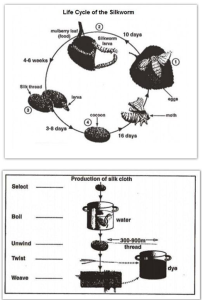Question –
WRITING TASK 1
You should spend 20 minutes on this task.
The diagrams below show the life cycle of the silkworm and the stages in the production of silk cloth.
Summarise the information by selecting and reporting the main features and making comparisons where relevant.
Write at least 150 words.

Answer –
The illustrations depict the silkworm’s life cycle and the stages involved in manufacturing silk.
Overall, the first diagram represents a 4-stage, natural, cyclical process. It begins with a moth laying eggs and culminates in the birth of a new moth from a cocoon. However, silk production is a man-made, linear process comprising six main stages.
The process begins when a moth lays eggs, and after 10 days, they hatch, and silkworm larvae come out of them, whose primary feed is mulberry leaves. After 4 to 6 weeks from their birth, these larvae start wrapping themselves in a silk thread, and to completely wrap themselves and construct a cocoon, they take anywhere from 3 to 8 days. They stay there for 16 days before emerging as fully-developed moths, and when the moths lay eggs, the process begins all over again.
In order to produce silk, a cocoon is initially selected and then put in boiling water to loosen its threads. Then, the silk threads are untangled and unwound, and they are usually between 300 and 900 meters long. After threads are obtained, they are either twisted and dyed or twisted, weaved, and then dyed.
